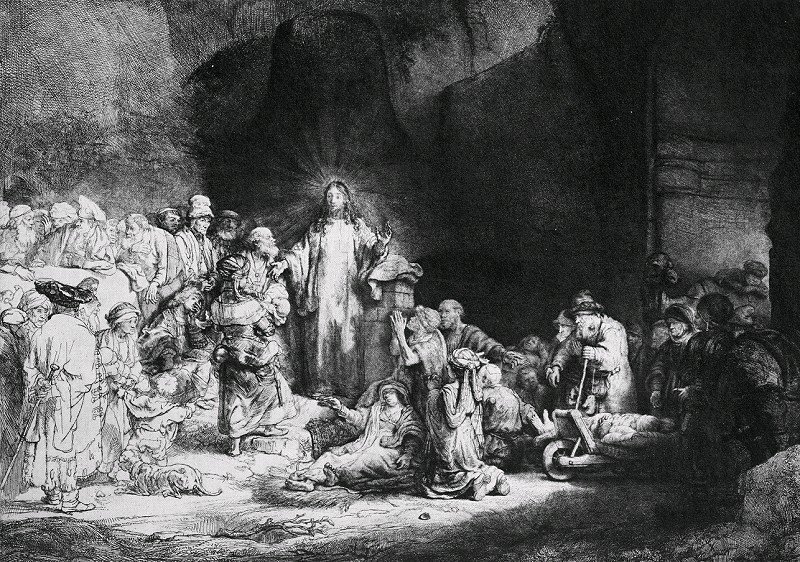
Biblical art has been a growing interest of mine as I've sought to visually illustrate the Bible for my college classes at Sterling College and sermons at the Congregational Church.
Rembrandt's etching, "The Hundred Guilder Print," is of particular interest. Not only does the print beautifully portray the ministry of Jesus, the story behind the etching's title has the potential of illustrating a key a Christian doctrine--redemption.
According to the Pocket Dictionary of Theological Terms, redemption expresses the theological idea that "sinful humans are 'bought back' from the bondage of sin into relationship with God through grace by the 'payment' of Jesus’ death." Redemption is one of the metaphors used by the Bible to explain God's work of salvation.
According to two websites, art scholar Christopher White traced the title's origin, "to a print seller named Mariette, who sold an impression of this print to Rembrandt himself for 100 guilders." If true, the story would be a terrific illustration of redemption. As Rembrandt bought back at great price his very own print, so Jesus at the cross paid a high price to buy back his own (Mark 10:45; 1 Corinthians 7:23).
To verify the story, I went to the library and looked up Christopher White's Rembrandt as an Etcher (Yale University Press, 2nd ed., 1999). In chapter three, White states:
The apotheosis of Rembrandt's activity in etching in the 1640's, and according to popular opinion of his whole career, is the large etching known as The Hundred Guilder Print. The origin of the title can be traced back to the story that the artist himself bought back an impression of the print for one hundred guilders.Much to my surprise, this is all White says about the origin of the print's title. No mention is made about Rembrandt buying back his print from a dealer named Mariette. Nothing is said about where this story originated. However, White footnotes his last sentence. In the book's back, footnote #56 from chapter three, it says this about the etching's famous name:
It first occurs in Conrad von Uffenbach's travel diary for 1711 (S. Slive, Rembrandt and His Critics 1630-1730 (The Hague, 1953), p. 167.When you go to Seymour Slive's book, here's what we find on pages 166-167:
De Geest's account of high prices which Dutch collectors were willing to pay for Rembrandt's work during these years is confirmed by Zacharias Conrad von Uffenbach, a German traveler, who was Holland in 1711. Uffenbach makes the earliest exant reference to Rembrandt's etching of Christ with the Sick Around Him, Receiving Little Children, as The Hundred Guilder Print in his Merkwurdige Reisen durch Niedersachsen, Holland und Engelland; he writes that he visited the cabinet of David Bremer of Amsterdam on March 1, 1711 in order to see his prints:Notice that von Uffenbach states that the print in question was sold at an auction, but he doesn't identify who it was that paid the high price.
"He has a considerable number and among the most outstanding a great number of Rembrandts; surely he had the best, but not the so-called Hundred Guilder Print, which is called thus because it once brought that high price at an auction. It represents the miracle of Christ where he heals a blind and deaf man..."
Then in footnote #1 at the bottom of page 167, Slive reports on further work he did to find out just how The Hundred Guilder Print received it's famous name. Here's what he says about his fact-finding mission:
The author has been unable to learn which collector or dealer paid 100 guilders for the etching of Christ with the Sick Around Him and at what sale this bid was made.So did Rembrandt actually pay the exorbitant price of one hundred guilders to buy back his own print of Jesus?
Unfortunately, I don't think the claim can be made with certainty. While Rembrandt was an avid art collector, it seems this particular story is more legend than fact.
I wish Christopher White said more about how the story was "traced back" to Rembrandt. In the meantime, it appears that the research of Seymour Slive is closer to the actual truth.
And those facts, ironically, are a mystery.




No comments:
Post a Comment